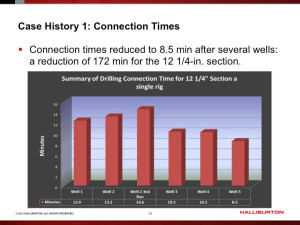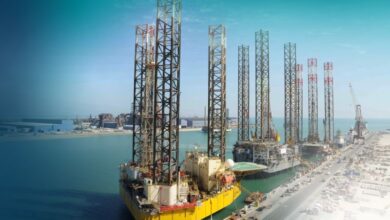Automated rig activity analysis offers more precise method for reducing NPT, invisible lost time

By Katie Mazerov, contributing editor
An automated system from Halliburton aims to help the industry analyze rig activities to more precisely identify efficiencies and inefficiencies by measuring in detail the impact of each distinct activity on total rig time. “The challenge with conventional manual reporting is that the documentation is often difficult to understand and disseminate accurately,” Chris Marland, production champion, ADT Drilling Optimization for Halliburton, explained in a presentation at the 2013 IADC Critical Issues Asia Pacific Conference, 20-21 November in Bangkok. “Resolution of that kind of data also can be limited because it depends on the attention to detail by the person entering the information,” he said.
A key driver in operators’ efforts to improve performance is nonproductive time (NPT), which continues to average 20% to 25% every year, Mr Marland pointed out. “Under the traditional reporting system, classification of NPT is not consistent. Different operators have different methods and requirements for entering NPT.” Some use stuck pipe as an indicator of NPT. Another common performance driver is rate of penetration (ROP). “Again, there is not always a standard as to what constitutes ROP,” he said. “For some operators, ROP is defined by how long it takes to make the bit run. For others, it is shoe-to-shoe performance.”
An issue that is receiving increasing attention is invisible lost time (ILT), which doesn’t always lead to downtime but does impact well delivery costs, Mr Marland said. “ILT typically involves short-duration, high-frequency activities, such as making connections, that are not effectively tracked with conventional 15- or 30-minute reporting. But, when compounded, they can add a lot of extra time to the operation. One extra minute spent making a connection in a 10,000-ft section adds 100 minutes to the operation.”
Halliburton’s MaxActivity monitoring software uses high-resolution surface data to define discrete activities to a one-section accuracy, Mr Marland said. The system applies a standard algorithm to activity analysis that can be applied across multiple rig operations, including drill speed, bit depth, flow rates, rotational speed and hookload or in-slips measurements. The analysis separates out three major activities, tripping, drilling and tripping out. Tripping is further defined by riser, casing liner and open-hole environment.
The system also breaks out the detail on where time is spent and whether the right amount of time is spent on specific activities, such as rotating or sliding while drilling, reaming up or down, washing and circulating. “We can’t track efficiency unless we know how much time we’re supposed to spend performing a specific activity,” Mr Marland said. “Many operators have performance targets, but unless they know how long they are spending on an activity, they won’t know if the operation is efficient or not.”
The automated rig activity analysis compares the efficiency of more than 45 activities with a set performance target. In analyzing 12 ¼-in. well section on a single rig for an operator in the Asia Pacific, the system compared total connection times and connection times of day crews and night crews. The day shift averaged 11 minutes per connection, the night shift 14 minutes, while both shifts averaged 12 to 13 minutes. By establishing competition between the crews with a reward for the best-performing crew, the operator was able to reduce time for each connection to 8 ½ minutes, a savings of four minutes per connection and a total of 172 minutes for the 12 ¼-in. section.
Automated rig activity measurement also can help operators to verify new technologies. “New technology is marketed to improve performance and save time and money, but how do we know that technology is really delivering benefit?” Mr Marland asked. The Halliburton system was used by an operator to verify that a new casing handling system for 9 ⅝-in. casing was improving handling times from an average of 12.5 joints per hour to 15.3 joints per hour, a savings of two to 5 ½ hours depending on well depth.
MaxActivity is a trademarked term of Halliburton.




